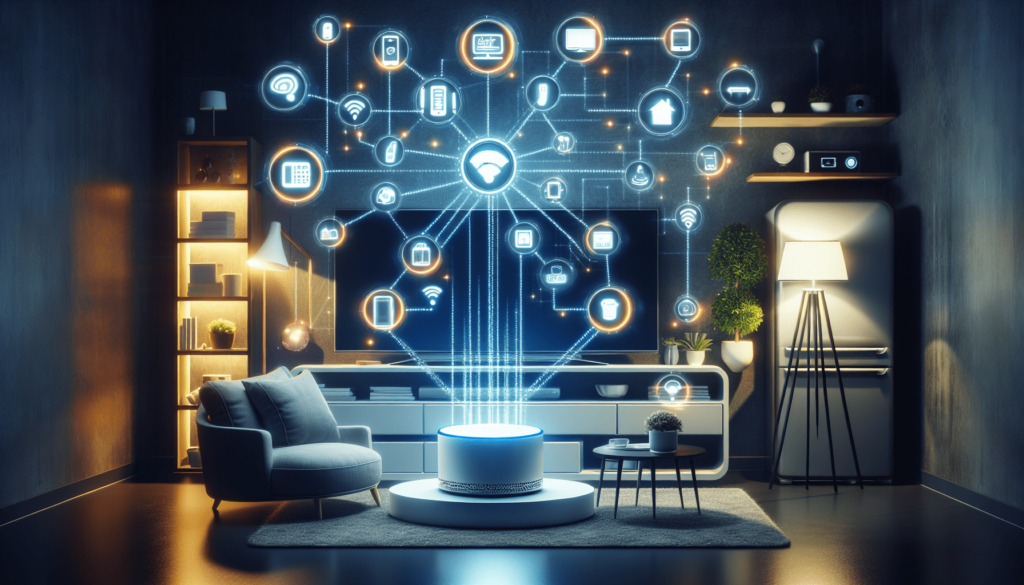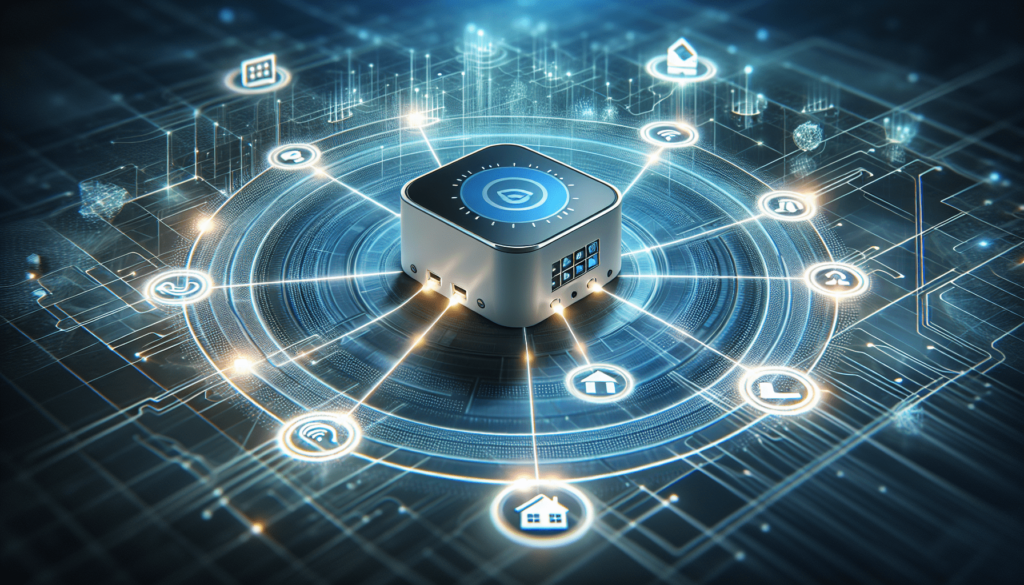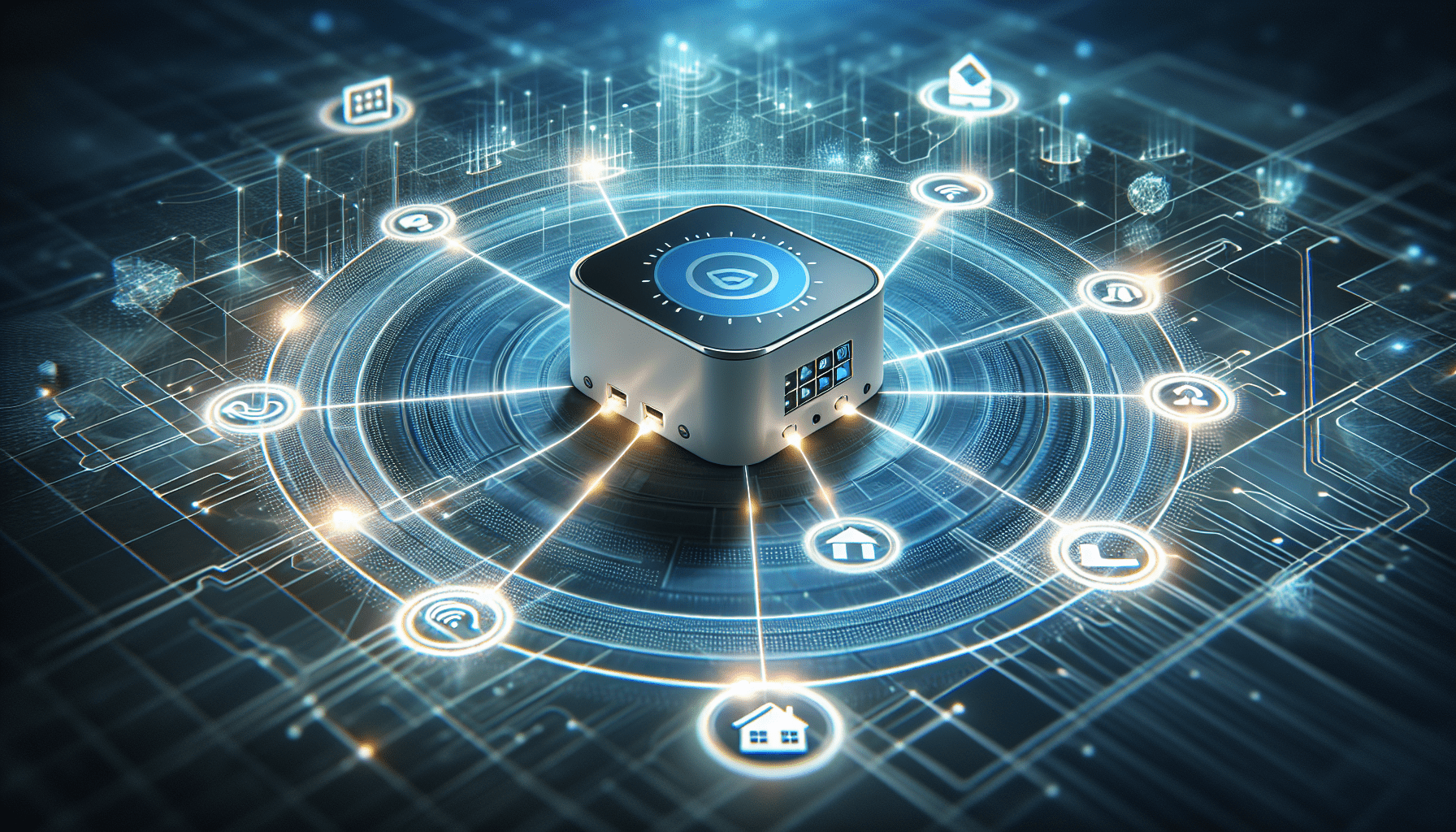Imagine living in a world where everyday objects around you are interconnected, seamlessly communicating and exchanging data. This is the concept behind the Internet of Things (IoT), a cutting-edge technology that is revolutionizing the way we live and work. In today’s application of IoT, it encompasses a vast network of devices ranging from smart home appliances to industrial machinery, all connected through the internet. With the potential to enhance efficiency, improve productivity, and create a more convenient lifestyle, the concept of Internet of Things is shaping the future in unimaginable ways.

Definition of Internet of Things
The Internet of Things, or IoT, is a concept that refers to the interconnection of various devices and objects through the internet. It involves the ability of these devices to collect and share data with each other, as well as to communicate and interact with humans. In simple terms, IoT is about connecting everyday objects to the internet so that they can be remotely controlled, monitored, and accessed.
Explanation of Internet of Things
The Internet of Things has revolutionized the way we live and work by enabling smart and connected solutions. Through IoT, devices such as smartphones, wearable gadgets, home appliances, industrial equipment, and even vehicles can be interconnected, allowing for seamless communication and data exchange. This interconnectedness allows for the creation of intelligent systems that can automate processes, optimize resource utilization, and enhance overall efficiency.
Overview of interconnected devices
The concept of the Internet of Things revolves around the idea of connectivity between devices. These devices can range from everyday objects such as smartphones, watches, and thermostats to more complex machinery and systems used in industries, healthcare, and transportation. By connecting these devices to the internet, they become capable of exchanging information, receiving commands, and promoting real-time collaboration.
The interconnectedness of devices extends beyond traditional computing devices, encompassing a wide range of physical objects and sensors. For example, sensors embedded in homes can monitor energy usage and adjust temperature settings, while wearable devices can track health metrics and relay them to healthcare professionals. This web of interconnected devices forms the backbone of the Internet of Things.
Importance of IoT in today’s world
The Internet of Things plays a crucial role in today’s world by offering countless opportunities for innovation and improvement in various sectors. IoT enables the collection of vast amounts of data from connected devices, which can then be analyzed and utilized to make informed decisions and drive efficiency.
In addition, IoT has the potential to improve the quality of life for individuals, enhance business operations, and contribute to sustainable development. By integrating IoT into various aspects of daily life, we can create smart homes, improve healthcare monitoring, optimize transportation systems, streamline industrial processes, revolutionize retail experiences, build smart cities, and much more.

Components of IoT
To understand the Internet of Things, it is essential to grasp the key components that make it possible. These components include sensors and actuators, connectivity protocols, cloud computing, and data analytics and processing.
Sensors and actuators
Sensors are at the core of the IoT infrastructure. They are responsible for collecting data from the surrounding environment and converting it into a digital format that can be processed and analyzed. Sensors can measure various conditions such as temperature, humidity, light intensity, motion, sound, and more.
Actuators, on the other hand, are devices that can initiate physical actions based on the data received from the sensors. They can control devices and systems by executing commands or making adjustments in response to the collected data.
Connectivity protocols
Connectivity protocols are the communication standards that enable devices and systems to exchange data. These protocols define the rules and mechanisms for data transmission between connected devices. Examples of connectivity protocols commonly used in IoT include Wi-Fi, Bluetooth, Zigbee, NFC, and cellular networks.
Cloud computing
Cloud computing plays a crucial role in IoT by providing a scalable and flexible infrastructure for storing, processing, and analyzing the massive amounts of data generated by IoT devices. The cloud serves as a central hub where data from various sources can be securely stored and accessed. Cloud computing also allows for real-time data processing and enables remote access and control of connected devices.
Data analytics and processing
Data analytics and processing are essential components of the IoT ecosystem as they enable the extraction of valuable insights from the vast amounts of data collected by IoT devices. By applying advanced analytics techniques, such as machine learning and artificial intelligence, IoT data can be analyzed to uncover patterns, predict outcomes, and make data-driven decisions.
Applications of Internet of Things
The Internet of Things has numerous applications across various industries and sectors. Here are some of the key areas where IoT is making a significant impact:
Smart homes
In smart homes, IoT allows for the integration and automation of various household systems and appliances. From controlling the temperature and lighting to managing security systems and monitoring energy consumption, IoT enables homeowners to have more control and efficiency over their living spaces.
Healthcare
IoT is transforming healthcare by enabling remote patient monitoring, telemedicine, and personalized health management. Wearable devices and smart health trackers can collect real-time health data, allowing healthcare professionals to remotely monitor patients’ vital signs, track medication adherence, and deliver personalized care.
Transportation and logistics
IoT is revolutionizing the transportation and logistics industry by improving efficiency, safety, and sustainability. Connected vehicle systems enable real-time monitoring of vehicle performance, optimize routes, and enhance driver safety. IoT also enables tracking and tracing of goods, reducing delays and optimizing supply chain operations.
Industrial IoT
In industrial settings, IoT is driving the concept of Industry 4.0, where machines, sensors, and systems are interconnected to create smart factories. Industrial IoT enables real-time monitoring of equipment, predictive maintenance, and optimization of production processes. It helps businesses achieve higher productivity, quality control, and cost efficiency.
Retail and supply chain management
IoT has the potential to revolutionize the retail industry by improving inventory management, enhancing customer experiences, and optimizing supply chain operations. Connected retail devices, such as smart shelves and RFID tags, enable retailers to track and manage inventory in real-time, while IoT-powered analytics provide valuable insights into customer behavior and preferences.
Smart cities
IoT plays a crucial role in building smart cities by connecting various urban systems, such as transportation, energy, waste management, and public safety. Smart city solutions leverage IoT to improve energy efficiency, optimize traffic flow, enhance public services, and ensure effective resource allocation.
Benefits of IoT in Today’s Applications
IoT brings numerous benefits to its various applications in today’s world. These benefits include:
Improved efficiency
By enabling real-time monitoring, automation, and optimization of various processes, IoT leads to improved efficiency in both domestic and industrial settings. IoT systems can analyze data and make adjustments on the fly, reducing waste, optimizing resource utilization, and improving overall productivity.
Cost reduction
IoT solutions provide cost savings by streamlining operations, optimizing energy usage, reducing maintenance costs, and minimizing downtime. By collecting data on equipment performance and predicting failures, IoT helps minimize unexpected breakdowns and maintenance expenses.
Enhanced safety and security
IoT plays a vital role in improving safety and security in various contexts. For example, in the healthcare sector, IoT-enabled remote patient monitoring ensures timely medical interventions and reduces the risk of adverse events. In smart homes, IoT security systems provide real-time monitoring and alerts, protecting occupants from potential threats.
Real-time monitoring and control
IoT allows for real-time monitoring and control of various systems and processes. Whether it’s monitoring energy usage in smart homes or tracking vehicle performance in logistics, IoT provides instant access to data and enables timely interventions and decision-making.
Predictive maintenance
One of the most significant advantages of IoT is its ability to enable predictive maintenance. By collecting and analyzing data from connected devices, IoT can predict and prevent equipment failures, schedule maintenance proactively, and optimize maintenance operations. This proactive approach minimizes downtime, extends equipment lifespan, and reduces overall maintenance costs.
Challenges of Implementing IoT
While the Internet of Things brings numerous benefits, its implementation also poses several challenges. These challenges include:
Security and privacy concerns
With the proliferation of connected devices and the exchange of vast amounts of data, security and privacy become critical concerns in IoT. Protecting data from unauthorized access, ensuring device authentication, and safeguarding against cyber-attacks are significant challenges that must be addressed in IoT implementations.
Interoperability issues
The wide variety of devices, protocols, and platforms used in IoT can create interoperability challenges. Ensuring seamless communication and compatibility between different devices and systems is crucial to realize the full potential of IoT. Standardization efforts and the development of open protocols and frameworks are essential in overcoming these interoperability challenges.
Data management and analytics
Managing and analyzing the enormous volumes of data generated by IoT devices pose significant challenges. Storing, processing, and analyzing this data in a timely and efficient manner require robust infrastructure and advanced analytics capabilities. IoT implementations need to address these challenges to make the most of the collected data’s insights.
Scalability and complexity
As the number of connected devices increases, scaling IoT systems becomes challenging. Managing a vast network of devices, ensuring reliable connectivity, and handling the influx of data require scalable and robust infrastructure. Additionally, the complexity of designing, deploying, and maintaining IoT systems can be daunting and require specialized skills and expertise.
Emerging Trends in IoT Applications
As the Internet of Things continues to evolve, several emerging trends are shaping its applications. These trends include:
Edge computing
Edge computing is a paradigm that brings computing power closer to the devices and sensors at the edge of the network. By processing data locally, at the edge, instead of sending it to the cloud, edge computing reduces latency, improves real-time decision-making, and saves bandwidth. Edge computing is particularly relevant in IoT applications that require real-time processing and low latency.
Artificial intelligence and machine learning
The combination of IoT and artificial intelligence (AI) and machine learning (ML) is a significant trend in IoT applications. AI and ML algorithms can analyze vast amounts of data collected by IoT devices to uncover patterns, detect anomalies, and make predictions. This integration allows for more intelligent decision-making, automation, and optimization of processes.
Blockchain technology
Blockchain technology, known for its use in cryptocurrencies, is finding applications in IoT as well. Blockchain can facilitate secure and transparent transactions between IoT devices, ensuring data integrity and ownership. It also enables the creation of decentralized IoT networks, reducing the reliance on centralized authorities and enhancing security.
5G connectivity
The deployment of 5G networks is set to revolutionize IoT applications by providing faster, more reliable, and low-latency connectivity. 5G networks offer higher data transmission speeds and improved network capacity, enabling real-time communication between devices. This enhanced connectivity opens up new possibilities for IoT applications that require near-instantaneous data exchange.
Future Outlook of IoT
The future of the Internet of Things looks promising, with continued growth and expansion in various industries and sectors. Key aspects of the future outlook for IoT include:
Continued growth and expansion
The number of connected devices and the volume of data generated by IoT is projected to increase exponentially in the coming years. The growth of IoT will be driven by advancements in technology, increased adoption in various sectors, and the emergence of new use cases. This growth will create new opportunities and drive innovation in the IoT ecosystem.
Transformation of various industries
IoT has the potential to transform various industries, leading to increased productivity, efficiency, and innovation. Sectors such as manufacturing, healthcare, transportation, agriculture, and energy are already experiencing significant changes through IoT adoption. As the technology evolves further, more industries will leverage IoT to optimize processes, improve customer experiences, and gain a competitive advantage.
Integration with other technologies
IoT will continue to integrate with other technologies, such as AI, ML, blockchain, and augmented reality (AR). These synergies will enhance the capabilities and outcomes of IoT applications, enabling more advanced automation, intelligent decision-making, and immersive experiences.
Ethical and regulatory considerations
As IoT becomes more pervasive, ethical and regulatory considerations become essential. Ensuring the responsible use of IoT, protecting privacy, and addressing potential social and ethical implications will be crucial. Governments and industry bodies will need to develop frameworks and regulations to ensure the ethical and secure deployment of IoT technologies.
Case Studies on IoT Implementation
To further illustrate the practical applications and benefits of IoT, let’s explore a few case studies:
Smart grid systems
Smart grid systems leverage IoT technology to optimize energy distribution and consumption. By integrating sensors and smart meters, utilities can collect real-time data on energy usage, identify inefficiencies, and improve grid resilience. Smart grid systems enable more precise billing, load balancing, and the integration of renewable energy sources.
Connected cars
Connected cars, equipped with IoT technology, are transforming the automotive industry. IoT enables real-time monitoring of vehicle performance, predictive maintenance, and enhanced safety features. Connected cars can also provide services such as real-time traffic updates, remote vehicle control, and emergency assistance.
Smart agriculture
IoT is revolutionizing the agriculture industry by enabling precision farming and smart irrigation systems. By deploying sensors in fields, farmers can monitor soil conditions, weather patterns, and crop health in real-time. This data helps optimize resource usage, reduce water consumption, and improve overall crop yield.
Wearable devices
Wearable devices, such as fitness trackers and smartwatches, are popular examples of IoT applications. These devices collect and analyze personal health data, allowing individuals to track their exercise, monitor vital signs, and receive personalized recommendations. Wearables have the potential to transform healthcare and promote preventive and proactive approaches to wellness.
Conclusion
In conclusion, the Internet of Things is reshaping the way we live and work, offering endless possibilities for innovation and improvement. It connects everyday objects and devices to the internet, allowing for seamless communication, data sharing, and automation. IoT has applications in various industries, including smart homes, healthcare, transportation, retail, and industrial settings.
The benefits of IoT include improved efficiency, cost reduction, enhanced safety, and real-time monitoring and control. However, implementing IoT comes with challenges such as security concerns, interoperability issues, data management, and scalability. Emerging trends in IoT, such as edge computing, AI, blockchain, and 5G connectivity, are opening up new opportunities and driving further innovation.
Looking ahead, the future of IoT holds continued growth, industry transformation, integration with other technologies, and ethical considerations. As IoT becomes more pervasive, it is essential to address challenges and ensure responsible and secure deployment. With its potential to revolutionize industries, enhance everyday lives, and drive economic growth, IoT will continue to be at the forefront of technological advancements.
